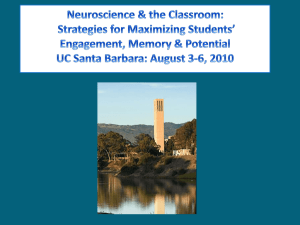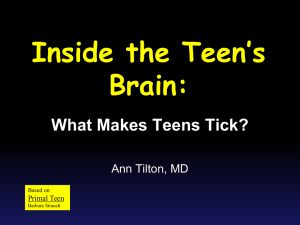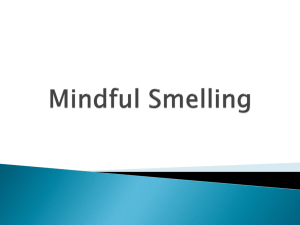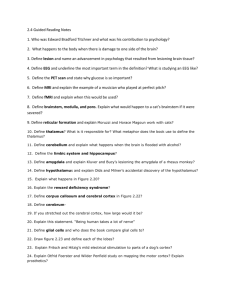University Studies 15A: Consciousness I
advertisement
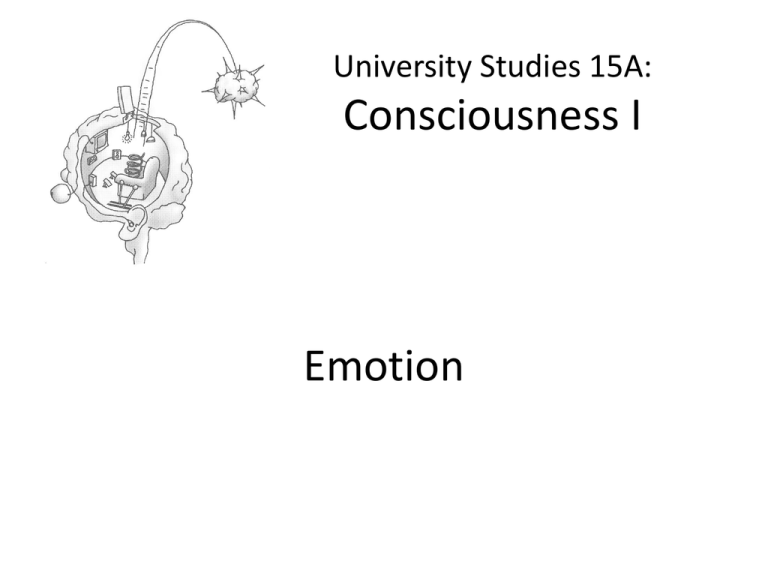
University Studies 15A: Consciousness I Emotion Emotion will be a central element in our account of the neuroscience of consciousness. The systems that underlie what we think of as emotion provide a way to account for saliency, what grabs our attention. But it goes much deeper. It lies at the heart of our manner of engaging the world. It structures the subjective quality of what it is like to be in the world. “Emotion” as we shall discuss it, has three distinct aspects: 1. We will begin with a substratum of “background feelings” deriving from the brain stem. 2. We next will consider “primary emotions,” the hardware interrupts of the cognitive system. 3. We then will begin to look at how processes of learning elaborate primary emotions into the core of the semantic system and simultaneously incorporate the background feelings into the subjective dimension of the semantic network Part One: the Base Beat from the Brain Stem Our story begins with a sad but rare affliction, hydranencephaly. Sometimes the Telencephalon of a fetus suffers injury and never develops into the cortex, and an infant is born with just the brain stem and diencephalon. However, this fact usually is not discovered until several weeks after birth. During the first weeks after birth, the infant’s cortex does not have sufficient myelin to function significantly, and the body relies primarily on the brain stem and diencephalon structures to function. As Antonio Damasio describes them, “To a limited but by no means negligible extent, they can communicate with their caregivers and interact with the world…. [T]hey move their heads and eyes freely, they have expressions of emotions on their faces, they can smile at a stimulus that one would expect a normal child to smile at—a toy, a certain sound—and they can even laugh and express normal joy when they are tickled.” (Self Comes to Mind, pp. 80-81) That is, the brain stem, aided by the thalamus and colliculi, has an astonishing amount of processing power. For humans this design is necessary because the cortex simply is not function for the first few weeks after birth as its basic networks are being prepared and trained. The brain stem tracks most of the visceral information provided to the brain: Heart rate Oxygen levels Perspiration and blushing Pain (both mechanical and thermal) The state of contraction of the smooth muscles of the gut, arteries, and lungs Collectively, the transmission of this information to the brain is called interoception. It turns out that the brain stem passes all this sensory data on to the thalamus. The thalamus in turn passes it to a fifth lobe. We know four lobes at present: 1. Occipital lobe 2. Parietal lobe 3. Temporal lobe 4. Frontal lobe The Insula Meet the fifth: Although the insula is a complex set of regions, at least part of it appears to serve as the cortical equivalent of the primary visual cortex for visceral data. For example, there appears to be a body (somatotopic) map for different types of pain The insula also processes and organizes the other forms of data. It then passes this processed data upstream to the amygdala, hippocampus, and multimodal integration areas. That is, via the insula, the brain integrates visceral responses into its systems for memory, decision, and saliency. Our heartbeat (and perspiration) on our first dates are part of episodic memory courtesy the insula and its ties to the brainstem. Damasio compellingly argues that the brainstem and the insula provide the “feel” of experience as it is represented in the cortex. This system provides a core “self,” a representation of the visceral subject in the cortex that then becomes elaborated through its integration and articulation within the systems for memory and meaning. This “self” system functions all the time, providing a steady stream of information about the visceral body to the cortical regions responsible for assessment of the current state of the world. The cortical system for assessing the incoming streams of data when at rest and without attentional focus is the “Default Mode” network. (We will discuss the network next week.) Part Two: Emotion “Affective neuroscience,” the neuroscientific study of emotion, sees primary “emotions” as a set of interfaces (i.e. specialized brain structures) that tells the cortex to pay attention to immediate needs. Baars and Gage list seven basic physiological “emotion” systems: 1. FEAR (fear, anxiety) 2. SEEKING (interest, curiosity) 3. RAGE (anger, contempt) 4. PANIC (sadness, shyness, guilt shame) 5. LUST (erotic feelings, jealosy) 6. CARE (love) 7. PLAY (joy, happiness) It is important to get the argument here right. The basic idea is a distinction between deep, primitive triggers and highly articulated emergent behavior. Consider two examples. The PANIC system is perhaps built upon a very simple “cyclical distress” mode. New-born infants experience periods of cortisol-mediated distress that appears to be unrelated to any particular external cause. This distress often can be extinguished simply when a face appears in the visual field or if the infant is picked up. How the infant analyzes the elements associated with this distress and with relief from the distress will lay the foundation for a wide class of social emotions. The SEEKING system may be built on a dopamine-mediated positive response to the unexpected. For a new-born infant, almost everything is unexpected. As the infant becomes just a bit older and both sensory cortices and memory systems become functional, how different categories of the unexpected turn out and under what circumstances will shape patterns of engagement with the world. All of this begins to happen long before the infant has language and before any later episodic memories are made. These early encounters between the primary emotional systems and the world of just barely processed objects will lay the foundation for the “self” and the semantic network of which the “self” is a part. Note the role of the insula in these emotions (the viscera make their contribution): Many years pass and we get a highly articulated world of emotional categories: However, affective neuroscience is mostly concerned with the early story and with the on-going systemic relations between the “primary emotion” systems and the cortical regions that feed into and receive input from the “primary emotions.” I will follow Baars’ and Gage’s example and consider the two best studied systems, FEAR and SEEKING. The center of the FEAR system is the amygdala, the subcortical structure next to the end of the hippocampus amygdala hippocampus Although small, the amygdala is internally complex and has complex afferents (pathways of signals coming in) and efferents (pathways for signals going out to other regions.) Below is the flow of activation started by sensory data. Baars and Gage present the pathways with a medial view of the brain: Afferents (Note that Baars and Gage do not show the connections to the sensory association areas here) Efferents (Note that Baars and Gage do not show the connections to the sensory association areas here) The amygdala’s connections to the visual system (Note the connections to both the visual object network (ITC) and to the primary visual cortex) The result of all these connections are the two distinct paths to activation of the amygdala: the so-called “low road” and the “high road” The visual system also uses the “low road:” the superior colliculus receives input from the thalamus. It will activate the amygdala if there is a dark, curved shape in the periphery of vision. Visual discrimination through this route is very poor: this is a “better safe than sorry” design that has survived from early ancestral primates. Once the amygdala is activated, attentional resources and body-state resources are turned to attend to the sensory data and the internal analysis. The “feeling” of fear comes from the hormones let loose in the process: Note that the hippocampus is a target both for the Noradrenaline (“fight-or-flight” response: increased heart rate, glucose into blood stream) and the Cortisol (stress: increase blood glucose). This will be important in learning. The central system for the SEEKING system are the Dopamine Pathways. Note once again the pattern of two pathways: The first is subcortical: the “mesolimbic dopamine pathway” between the VTA in the brainstem and the nucleus accumbens (part of the basal ganglia) in the forebrain. The second, cortical pathway builds on the first: the “mesocortical dopamine pathway” is between the orbitofrontal cortex (right above the “orbits” of the eyes) and the VTA. For functional connectivity once the dopamine is produced, it operates in the frontal cortex far beyond the orbitofrontal cortex that is part of the control loop: The result of the connection between the direct dopamine pathways and the rest of the cortex is a system that responds to errors in prediction of rewards. As Baars and Gage explain: 1. Dopamine neurons fire at unexpected rewards and novel events. 2. Dopamine neurons stop firing when rewards become predictable or the event ceases to be novel. 3. Dopamine neurons start firing when conditioned stimuli (eg., a bell ringing) prove to predict a reward (the food pellet arriving, an unconditioned stimulus). 4. Dopamine neurons are inhibited when the conditioned stimulus fails to produce the predicted reward. 5. Dopamine neurons stop firing when the conditioned stimulus reliably predicts the reward. Hence, the dopamine system fires at errors in prediction of rewards. This does not seem very remarkable, but the brain really “likes” dopamine and is built to pay attention to what produces dopamine. In adults, dopamine is involved in addictions, cravings, an compulsive behavior. In babies, dopamine responses help shape what is noticed and remembered. It helps shape the dimensional logic of memory and the structure of the semantic system. That is, the emergent self, our likes, dislikes, values, what we notice, and the manner in which we engage the world all are fundamentally mediated by a developmental logic shaped by the primary emotions.

